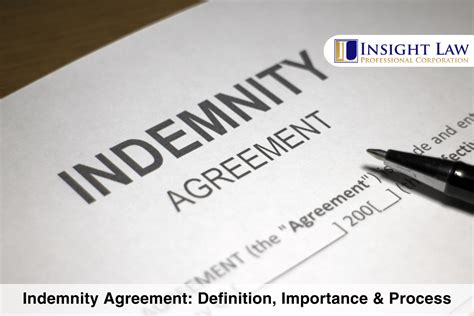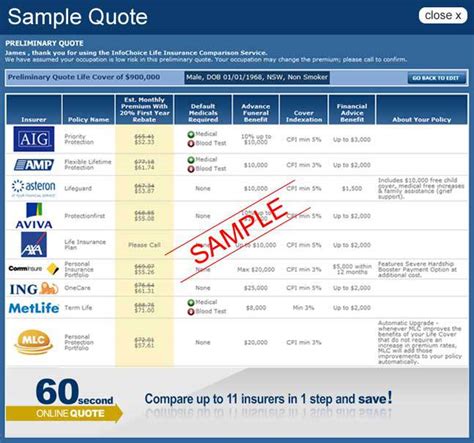Indemnity Definition Insurance

Indemnity is a fundamental concept in the insurance industry, playing a crucial role in protecting individuals and businesses from various risks. This comprehensive article will delve into the intricacies of indemnity, its importance, and its applications in the insurance sector. By understanding indemnity, we can grasp the essence of how insurance policies provide financial protection and mitigate potential losses.
Understanding Indemnity in Insurance

Indemnity, in the context of insurance, refers to the legal obligation of an insurance company to compensate an insured individual or entity for losses or damages they incur. It is a key component of insurance contracts, ensuring that policyholders receive financial support to restore their financial stability in the event of an insured peril.
The concept of indemnity is rooted in the principle of restoring the insured to their pre-loss financial position. When a policyholder experiences a covered loss, the insurance company steps in to indemnify them, providing the necessary funds to repair, replace, or compensate for the loss. This restoration of financial stability is a cornerstone of the insurance industry's purpose.
Types of Indemnity Clauses
Insurance policies often include specific indemnity clauses that outline the terms and conditions under which the insurer will provide compensation. These clauses can vary depending on the type of insurance and the nature of the risk being insured.
Some common types of indemnity clauses include:
- First-Party Indemnity: This clause applies when the insured suffers a direct loss. It covers scenarios such as property damage, personal injury, or theft, where the insurance company indemnifies the policyholder for their own losses.
- Third-Party Indemnity: Third-party indemnity clauses protect the insured against claims made by others. This is common in liability insurance, where the policyholder is indemnified for damages caused to third parties.
- Loss of Use Indemnity: In certain cases, an insured may suffer losses due to the inability to use their property or services. Loss of use indemnity clauses provide compensation for the temporary loss of use, ensuring continuity during repairs or replacements.
- Business Interruption Indemnity: This type of clause is crucial for businesses. It indemnifies the insured for losses incurred due to business interruption, such as reduced revenue or increased expenses resulting from a covered event.
The Role of Indemnity in Insurance Policies

Indemnity serves as the backbone of insurance policies, shaping the relationship between insurers and policyholders. It defines the scope of coverage, establishes the insurer’s obligations, and provides a framework for resolving claims.
Determining the Scope of Coverage
Insurance policies are tailored to specific risks and coverages. Indemnity clauses help define the scope of what is insured and what is excluded. By carefully reading and understanding these clauses, policyholders can make informed decisions about their insurance needs.
For example, a homeowner's insurance policy may include an indemnity clause covering fire damage but exclude flood damage. Understanding this distinction is crucial for homeowners to ensure they have adequate protection against potential risks.
Establishing Insurer Obligations
Indemnity clauses outline the responsibilities of the insurance company in the event of a claim. They specify the conditions under which the insurer will provide compensation, the limits of coverage, and any deductibles or co-payments that may apply.
By clearly defining these obligations, indemnity clauses provide transparency and certainty to policyholders. It ensures that both parties understand their rights and responsibilities, fostering trust and confidence in the insurance process.
Resolving Claims and Dispute Resolution
When a policyholder experiences a loss, the indemnity clause plays a vital role in resolving claims. It provides a roadmap for the claims process, outlining the steps and documentation required to initiate and finalize a claim.
Indemnity clauses often include provisions for dispute resolution, such as arbitration or mediation, in cases where there is a disagreement between the insurer and the policyholder regarding the claim. These mechanisms help resolve disputes efficiently and fairly, ensuring a smooth claims process.
The Process of Indemnification
Indemnification is the process by which an insurer fulfills its obligation to compensate an insured individual or entity. It involves several key steps, ensuring a fair and efficient resolution of claims.
Initiating a Claim
When a policyholder experiences a loss, they must initiate a claim by notifying their insurance company. This typically involves providing details of the incident, such as the date, time, and circumstances of the loss, along with any supporting documentation.
The insurance company then reviews the claim, assesses the validity and extent of the loss, and determines whether it falls within the scope of the indemnity clause.
Assessing the Loss
During the assessment phase, the insurer evaluates the nature and extent of the loss. This may involve inspections, investigations, and the collection of evidence to determine the cause and impact of the loss.
The insurer considers various factors, including the policy terms, the indemnity clause, and any applicable exclusions or limitations. This assessment ensures that the claim is handled fairly and in accordance with the policy conditions.
Determining Compensation
Once the loss is assessed, the insurer determines the appropriate level of compensation based on the indemnity clause. This involves calculating the financial impact of the loss and applying any deductibles or policy limits.
The compensation may take various forms, such as reimbursements for repairs or replacements, cash payments, or other forms of financial support as outlined in the policy.
Payment and Settlement
After determining the compensation amount, the insurer proceeds with the payment or settlement process. This may involve issuing a check, transferring funds electronically, or providing other forms of financial support as specified in the indemnity clause.
The settlement process ensures that the policyholder receives the agreed-upon compensation in a timely manner, allowing them to restore their financial stability and recover from the insured loss.
Real-World Examples of Indemnity in Action
To illustrate the concept of indemnity, let’s explore some real-world scenarios where indemnity clauses have played a crucial role in protecting individuals and businesses.
Homeowner’s Insurance and Fire Damage
Imagine a homeowner’s policy with an indemnity clause covering fire damage. In the event of a fire, the policyholder can file a claim with their insurance company, providing evidence of the loss, such as photos, receipts, and estimates for repairs.
The insurer assesses the claim, verifies the cause and extent of the damage, and determines the appropriate compensation based on the indemnity clause. This may include reimbursements for repairs, temporary housing expenses, and even the replacement of personal belongings.
Business Liability Insurance and Customer Injury
A business owner has liability insurance with an indemnity clause covering customer injuries on their premises. If a customer slips and falls, resulting in injuries, the business owner can rely on the indemnity clause to protect them from potential lawsuits and financial losses.
The insurer assesses the claim, investigates the incident, and determines whether the business owner is liable. If the claim is valid, the insurer indemnifies the business owner, covering legal expenses, medical costs, and any compensation owed to the injured customer.
Automobile Insurance and Collision Damage
Automobile insurance policies often include indemnity clauses for collision damage. In the event of a car accident, the policyholder can file a claim with their insurance company, providing details of the accident and any relevant documentation.
The insurer assesses the claim, determines fault, and evaluates the extent of the damage. Based on the indemnity clause, the insurer provides compensation for repairs, replacement of parts, or even the total loss of the vehicle. This indemnity ensures that the policyholder can restore their vehicle and continue their daily activities without significant financial burden.
The Future of Indemnity and Insurance

As the insurance industry evolves, so too does the concept of indemnity. Technological advancements, changing risk landscapes, and emerging trends are shaping the future of indemnity and insurance.
Technological Innovations
Advancements in technology are revolutionizing the insurance industry. From digital claim processing to the use of artificial intelligence and machine learning, insurers are adopting innovative solutions to enhance the indemnity process.
For example, drones and satellite imaging are being used to assess property damage, reducing the need for physical inspections. This not only speeds up the claims process but also improves accuracy, ensuring a more efficient indemnification process.
Changing Risk Landscapes
The world is constantly evolving, and so are the risks that individuals and businesses face. Climate change, natural disasters, and emerging technologies present new challenges for the insurance industry.
As risks evolve, indemnity clauses must adapt to provide adequate protection. Insurers are developing new products and coverage options to address these changing risks, ensuring that policyholders have the necessary financial support in the face of unforeseen events.
Emerging Trends in Insurance
The insurance industry is embracing new trends and business models to stay relevant and competitive. These trends are influencing the way indemnity is approached and delivered.
- Parametric Insurance: This innovative approach provides predetermined payouts based on specific parameters, such as weather events or natural disasters. Parametric insurance offers swift indemnification, ensuring policyholders receive compensation quickly without the need for extensive loss assessments.
- Microinsurance: Microinsurance targets underserved populations, offering affordable and accessible insurance coverage. By providing small-scale indemnity, it empowers individuals and communities to protect themselves against common risks.
- Insurtech Partnerships: Insurers are collaborating with technology startups to enhance their indemnity offerings. These partnerships leverage innovative technologies, such as blockchain and smart contracts, to streamline the claims process and improve overall efficiency.
Conclusion
Indemnity is a cornerstone of the insurance industry, providing a legal framework for financial protection and compensation. By understanding the concept of indemnity, its role in insurance policies, and its real-world applications, we can appreciate the value and importance of insurance as a risk management tool.
As the insurance landscape evolves, so too will the practice of indemnity. By embracing technological innovations, adapting to changing risks, and exploring emerging trends, the insurance industry can continue to deliver effective indemnification, ensuring financial stability and peace of mind for individuals and businesses alike.
What is the primary purpose of indemnity in insurance policies?
+The primary purpose of indemnity is to restore the insured individual or entity to their pre-loss financial position. It ensures that policyholders receive financial compensation to repair, replace, or compensate for losses covered by the insurance policy.
How do indemnity clauses vary in different insurance policies?
+Indemnity clauses can vary based on the type of insurance and the nature of the risk being insured. They define the scope of coverage, exclusions, and the insurer’s obligations. It’s important to carefully review indemnity clauses to understand the specific terms and conditions of your insurance policy.
What happens if there is a dispute over an insurance claim?
+In cases of disputes, many insurance policies include provisions for dispute resolution, such as arbitration or mediation. These mechanisms provide a fair and efficient way to resolve disagreements between the insurer and the policyholder, ensuring a timely resolution of claims.
How do technological advancements impact the indemnity process?
+Technological advancements, such as digital claim processing, drones, and artificial intelligence, are revolutionizing the indemnity process. They improve efficiency, accuracy, and speed, allowing insurers to provide faster and more effective indemnification to policyholders.
What are some emerging trends in indemnity and insurance?
+Emerging trends in indemnity and insurance include parametric insurance, which provides predetermined payouts based on specific parameters, microinsurance for underserved populations, and Insurtech partnerships leveraging innovative technologies to streamline the claims process.



